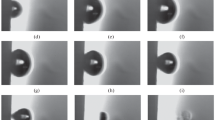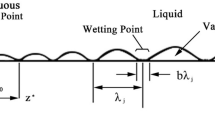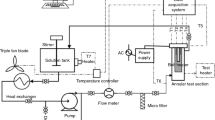Abstract
The article is the second part of the review devoted to the boiling of a liquid subcooled to the saturation temperature, the process which enables the removal of heat fluxes of extremely high density1 The first part presents the specific features of the process mechanism, together with its phenomenological model, and analyzes data on heat transfer and hydraulic resistance. This article is devoted to the heat-transfer crisis during subcooled boiling and the issues of heat-transfer enhancement. The heat-transfer crisis has been demonstrated to be caused by a sharp change in the flow structure involving the corresponding transformation of the heat-transfer mechanism, when the ensemble of individual bubbles is replaced with the regime of coalesced bubbles and vapor agglomerates, thereby causing the conditions facilitating the rupture of near-wall liquid films and the formation of dry spots increasing in size. The simplest and sufficiently effective relationship for calculating the critical heat flux (qcr) at high subcooling values is the modified empirical formula proposed by Tong. It has been concluded that it would be impractical to describe qcr by a single formula in the entire range of studied subcoolings. Several processes for modifying the heating surface to enhance heat transfer and increase qcr are briefly examined. Engineering problems arising in implementing these processes are discussed. The advisability of continuing comprehensive studies into the subcooled liquid boiling, primarily for understanding the physical features of the phenomenon, has been demonstrated.



Similar content being viewed by others
Notes
N.V. Vasil’ev, Yu.A. Zeigarnik, and K.A. Khodakov, Boiling in Forced Convection of Subcooled Liquid as a Method for Removing High Heat Fluxes (Review): Part 1. Characteristics, Mechanism and Model of the Process, Heat Transfer, and Hydraulic Resistance, Thermal Engineering, 69, 235–251 (2022).
REFERENCES
Yu. A. Zeigarnik, “On the universal burnout model of subcooled liquid in channels,” Teplofiz. Vys. Temp. 34, 52–56 (1996).
F. C. Gunther, “Photographic study of surface boiling heat transfer to water with forced convection,” J. Heat Transfer 73, 115–123 (1951).
S. Mirshak, W. S. Durant, and R. H. Towell, Heat Flux at Burnout, E. l. du Pont de Nemours and Company Report No. 355 (1959).
A. P. Ornatskii and A. M. Kichigin, “Investigation of the dependence of the critical thermal load on the weight velocity, subcooling and pressure,” Teploenergetika, No. 2, 75–79 (1961).
A. P. Ornatskii and L. S. Vinyarskii, “Heat transfer crisis in conditions of forced movement of subcooled water in small-diameter tubes,” Teplofiz. Vys. Temp. 3, 444–451 (1965).
V. N. Smolin and V. K. Polyakov, “Critical heat flux in the longitudinal flow in a bundle of rods,” Teploenergetika, No. 4, 54–58 (1967).
“Look-up tables data for calculating the heat transfer crisis in water boiling in uniformly heated round tubes,” Teploenergetika, No. 9, 90–92 (1976).
Yu. A. Zeigarnik, N. P. Privalov, and A. I. Klimov, “Critical heat fluxes during boiling of subcooled water in rectangular channels with one-sided heat supply,” Teploenergetika, No. 1, 48–51 (1981).
R. D. Boyd, “Subcooled water flow boiling experiments under uniform high heat flux conditions,” Fusion Sci. Technol. 13, 131–142 (1988). https://doi.org/10.13182/FST88-A25090
R. D. Boyd, “Subcooled water flow boiling transition and the L/D effect on CHF for a horizontal uniformly heated tube,” Fusion Sci. Technol. 18, 317–324 (1990). https://doi.org/10.13182/FST90-A29303
G. P. Celata, M. Cumo, and A. Mariani, “Burnout in highly subcooled water flow boiling in small diameter tubes,” Int. J. Heat Mass Transfer 36, 1269–1285 (1993). https://doi.org/10.1016/S0017-9310(05)80096-1
C. L. Vandervort, A. E. Bergles, and M. K. Jensen, “An experimental study of critical heat flux in very high heat flux subcooled boiling,” Int. J. Heat Mass Transfer 37, 161–173 (1994). https://doi.org/10.1016/0017-9310(94)90019-1
G. P. Celata, M. Cumo, and A. Mariani, “Geometrical effects on the subcooled flow boiling critical heat flux,” Rev. Gen. Therm. 36, 807–814 (1997).
Yu. A. Zeigarnik, A. I. Klimov, A. G. Rotinov, and B. A. Smyslov, “Some experimental results on burnout in subcooled water flow boiling,” Therm. Eng. 44, 184–191 (1997).
G. P. Celata, M. Cumo, A. Mariani, and G. Zummo, “Physical insight in the burnout region of water-subcooled flow boiling,” Rev. Gen. Therm. 37, 450–458 (1998).
I. Mudawar and M. B. Bowers, “Ultra-high critical heat flux (CHF) for subcooled water flow boiling — I: CHF data and parametric effects for small diameter tubes,” Int. J. Heat Mass Transfer 42, 1405–1428 (1999). https://doi.org/10.1016/S0017-9310(98)00241-5
G. P. Celata, M. Cumo, A. Mariani, and G. Zummo, “Burnout in subcooled flow boiling of water. A visual experimental study,” Int. J. Therm. Sci. 39, 896–908 (2000). https://doi.org/10.1016/S1290-0729(00)01175-3
I. C. Bang, S. H. Chang, and W. P. Baek, “Visualization of the subcooled flow boiling of R-134a in a vertical rectangular channel with an electrically heated wall,” Int. J. Heat Mass Transfer 47, 4349–4363 (2004). https://doi.org/10.1016/j.ijheatmasstransfer.2004.04.030
G. Bloch, W. Muselmann, M. Saier, and T. Sattelmayer, “A phenomenological study on effects leading to the departure from nucleate boiling in subcooled flow boiling,” Int. J. Heat Mass Transfer 67, 61–69 (2013). https://doi.org/10.1016/j.ijheatmasstransfer.2013.08.014
N. V. Vasil’ev, Yu. A. Zeigarnik, K. A. Khodakov, and I. V. Maslakova, “Experimental investigation of two-phase subcooled liquid flow structure under preburnout conditions,” Therm. Eng. 66, 798–803 (2019). https://doi.org/10.1134/S0040601519110077
N. V. Vasil’ev, Yu. A. Zeigarnik, K. A. Khodakov, and S. N. Vavilov, “Vapor agglomerates and dry spots as precursors of the subcooled liquid boiling crisi in a channel,” High Temp. 59, 373–383 (2021).
N. V. Vasiliev, Yu. A. Zeigarnik, and K. A. Khodakov, “Evolution of steam–water flow structure under subcooled water boiling at smooth and structured heating surfaces,” J. Phys.: Conf. Ser. 891, 012008 (2017). https://doi.org/10.1088/1742-6596/891/1/012008
Yu. A. Zeigarnik, N. V. Vasil’ev, E. A. Druzhinin, I. V. Kalmykov, A. S. Kosoi, and K. A. Khodakov, “Prospects for boiling of subcooled dielectric liquids for supercomputer cooling,” Dokl. Phys. 63, 58–60 (2018).
Y. Li, K. Fukuda, and Q. Liu, “Subcooled boiling FC-72 in vertical low diameter tubes,” in Proc. 16th Int. Heat Transfer Conf., Beijing, China, Aug. 10–15, 2018, pp. 6755–6760, paper id. IHTC16-23064. https://doi.org/10.1615/IHTC16.mpf.023064
D. D. Hall and I. Mudawar, “Ultra-high critical heat flux (CHF) for subcooled water flow boiling in tubes — II. CHF data base and design equations,” Int. J. Heat and Mass Transfer 42, 1429–1456 (1999). https://doi.org/10.1016/S0017-9310(98)00242-7
P. Saha and N. Zuber, “Point of net vapor generation and vapor void fraction in subcooled boiling,” in Proc. 5th Int. Heat Transfer Conf. (IHTC-5), Tokyo, Japan, Sept. 3–7, 1974 (Japan Society of Mechanical Engineers, Tokyo, 1974), Vol. 4, pp. 175–179. https://doi.org/10.1615/IHTC5.430
A. E. Bergles, “Burnout in boiling heat transfer. Part II. Subcooled and lowquality forced-convection systems,” Nucl. Saf. 18 (2), 154–167 (1977).
N. V. Vasil’ev, Yu. A. Zeigarnik, K. A. Khodakov, and V. M. Fedulenko, “The nature of "gas” burnout,” High Temp. 53, 837–840 (2015).
A. P. Ornatsky, “The effect of basic regime parameters and channel geometry on critical heat fluxes in forced convection of subcooled water,” Heat Transfer – Sov. Res. 1 (3), 17–22 (1969).
S. G. Kandlikar, “Critical heat flux in subcooled flow boiling — An assessment of current understanding and future directions of research,” Multiphase Sci. Technol. 13, 207–232 (2001). https://doi.org/10.1615/MultScienTechn.v13.i3-4.40
R. D. Boyd, “Subcooled flow boiling critical heat flux (CHF) and its application to fusion energy components. Part I. A review of fundamentals of CHF and related data base,” Fusion Technol. 7, 7–30 (1985). https://doi.org/10.13182/FST85-A24515
D. D. Hall and I. Mudawar, “Critical heat flux (CHF) for water flow in tubes — II.: Subcooled CHF correlations,” Int. J. Heat Mass Transfer 43, 2605–2640 (2000). https://doi.org/10.1016/S0017-9310(99)00192-1
G. P. Celata, M. Cumo, and A. Mariani, “Assessment of correlations and models for the prediction of CHF in water subcooled flow boiling,” Int. J. Heat Mass Transfer 37, 237–255 (1994). https://doi.org/10.1016/0017-9310(94)90096-5
L. S. Tong, “Boundary-layer analysis of flow boiling crisis,” Int. J. Heat Mass Transfer 11, 1208–1211 (1968). https://doi.org/10.1016/0017-9310(68)90037-9
G. P. Celata, M. Cumo, and A. Mariani, “CHF in highly subcooled flow boiling with and without turbulence promoters,” in Proc. European Two-Phase Flow Group Meeting, Stockholm, Sweden, June 1–3, 1992 (Stockholm, 1992), paper no. C1.
G. P. Celata, M. Cumo, and A. Mariani, “Subcooled water boiling CHF with very high heat fluxes,” Rev. Gen. Tech. 31, 106–114 (1992).
L. S. Tong, “An evaluation of the departure from nucleate boiling in bundles of reactor fuel rods,” Nucl. Sci. Eng. 33, 7–15 (1968). https://doi.org/10.13182/NSE68-A20912
J. Weisman and S. Ileslamlou, “A phenomenological model for prediction of critical heat flux under highly subcooled conditions,” Fusion Technol. 13, 654–659 (1988). https://doi.org/10.13182/FST88-A25140
Y. Katto, “A prediction model of subcooled water flow boiling CHF for pressure in the region 0.1–20.0 MPa,” Int. J. Heat Mass Transfer 35, 1115–1123 (1992). https://doi.org/10.1016/0017-9310(92)90172-O
C. H. Lee and I. Mudawar, “A mechanistic critical heat flux model for subcooled flow boiling based on local bulk flow conditions,” Int. J. Multiphase Flow 14, 711–728 (1988). https://doi.org/10.1016/0301-9322(88)90070-5
D. Hall and I. Mudawar, “Critical heat flux (CHF) for water flow in tubes — I. Compilation and assessment of the world CHF data,” Int. J. Heat Mass Transfer 43, 2573–2604 (2000). https://doi.org/10.1016/S0017-9310(99)00191-X
V. V. Yagov, Heat Transfer in Single-Phase Media and in Phase Transitions (Mosk. Energ. Inst., Moscow, 2014) [in Russian].
D. C. Groeneveld, L. K. H. Leung, P. L. Kirillov, V. P. Bobkov, I. P. Smogalev, V. N. Vinogradov, X. C. Huang, and R. Royer, “The 1995 look-up table for critical heat flux in tubes,” Nucl. Eng. Des., 163, 1–23 (1996). https://doi.org/10.1016/0029-5493(95)01154-4
G. Liang and I. Mudawar, “Review of channel flow boiling enhancement by surface modification, and instability suppression schemes,” Int. J. Heat Mass Transfer 146, 118864 (2020). https://doi.org/10.1016/j.ijheatmasstransfer.2019.118864
A. V. Dedov, “A review of modern methods for enhancing nucleate boiling heat transfer,” Therm. Eng. 66, 881–915 (2019). https://doi.org/10.1134/S0040601519120012
D. E. Kim, D. I. Yu, D. W. Jerng, M. H. Kim, and H. S. Ahn, “Review of boiling heat transfer enhancement on micro/nanostructured surfaces,” Exp. Therm. Fluid Sci. 66, 173–196 (2015). https://doi.org/10.1016/j.expthermflusci.2015.03.023
A. S. Surtaev, V. S. Serdyukov, and A. N. Pavlenko, “Nanotechnologies in thermophysics: Heat transfer and crisis phenomena in boiling,” Ross. Nanotekhnol. 11 (11–12), 18–32 (2016).
A. V. Dedov, A. T. Komov, A. N. Varava, and V. V. Yagov, “Hydrodynamics and heat transfer in swirl flow under conditions of one-side heating. Part 2: Boiling heat transfer. Critical heat fluxes,” Int. J. Heat Mass Transfer 53, 4966–4975 (2010). https://doi.org/10.1016/j.ijheatmasstransfer.2010.05.035
H. Kinoshita, T. Ioshida, H. Nariai, and F. Inasaka, “Study of the mechanism of critical heat flux enhancement for subcooled flow boiling in a tube with internal twisted tape under subcooled boiling conditions,” Heat Transfer Jpn. Res. 25, 293–307 (1996).
I. Mudawar and D. E. Maddox, “Enhancement of critical heat flux from high power microelectronic heat sources in a flow channel,” Trans. ASME: J. Electron. Packag. 112, 241–248 (1990). https://doi.org/10.1115/1.2904373
I. A. Popov, A. V. Shchelchkov, Yu. F. Gortyshov, and N. N. Zubkov, “Heat transfer enhancement and critical heat fluxes in boiling of microfinned surfaces,” High Temp. 55, 524–534 (2017).
M. C. Chyu and A. Bergles, “Horizontal-tube falling-film evaporation with structured surfaces,” J. Heat Transfer 111, 518–524 (1989). https://doi.org/10.1115/1.3250708
A. S. Surtaev, A. N. Pavlenko, D. V. Kuznetsov, V. I. Kalita, D. I. Komlev, A. Yu. Ivannikov, and A. A. Radyuk, “Heat transfer and crisis phenomena at pool boiling of liquid nitrogen on the surfaces with capillary-porous coatings,” Int. J. Heat Mass Transfer 108, 146–155 (2017). https://doi.org/10.1016/j.ijheatmasstransfer.2016.11.100
X. S. Wang, Z. B. Wang, and Q. Z. Chen, “Research on manufacturing technology and heat transfer characteristics of sintered porous surface tubes,” Adv. Mater. Res. 97–101, 1161–1165 (2010). https://doi.org/10.4028/www.scientific.net/AMR.97-101.1161
N. V. Vasil’ev, A. Yu. Varaksin, Yu. A. Zeigarnik, K. A. Khodakov, and A. V. Epel’fel’d, “Characteristics of subcooled water boiling on structured surfaces,” High Temp. 55, 880–886 (2017).
I. V. Suminov, P. N. Belkin, A. V. Epel’fel’d, V. B. Lyudin, B. L. Krit, and A. M. Borisov, Plasma-Electrolytic Surface Modification of Metals and Alloys (Tekhnosfera, Moscow, 2011), Vol. 2 [in Russian].
Z. Yao, Y. W. Lu, and S. G. Kandlikar, “Fabrication of nanowires on orthogonal surfaces of microchannels and their effect on pool boiling,” J. Micromech. Microeng. 22, 115005 (2012). https://doi.org/10.1088/0960-1317/22/11/115005
M. S. Sarwar, Y. H. Yeong, and S. H. Chang, “Subcooled flow boiling CHF enhancement with porous surface coatings,” Int. J. Heat Mass Transfer 50, 3649–3657 (2007). https://doi.org/10.1016/j.ijheatmasstransfer.2006.09.011
Yu. Kuzma-Kichta, A. Leontyev, A. Lavrikov, M. Shustov, and K. Suzuki, “Boiling investigation in the microchannel with nano-particles coating,” in Proc. 15th Int. Heat Transfer Conf., Kyoto, Japan, Aug. 10–15, 2014, paper id. IHTC15-9214. https://doi.org/10.1615/IHTC15.fbl.009214.
A. Bar-Cohen and C. A. Holloway, “Thermal science and engineering — from macro to nano in 2000 years,” in Proc. 15th Int. Heat Transfer Conf., Kyoto, Japan, Aug. 10–15, 2014, paper id. IHTC15-FL01. https://doi.org/10.1615/IHTC15.FL.000001
V. V. Kuznetsov and A. S. Shamirzaev, “Flow boiling heat transfer mechanism in minichannels,” in Proc. ASME 5th Int. Conf. on Nanochannels, Microchannels and Minichannels, Puebla, Mexico, June 18–20, 2007 (American Society of Mechanical Engineers, New York, 2007), in Ser.: Proceedings of ASME, Vol. 4272, pp. 1113–1121. https://doi.org/10.1115/ICNMM2007-30210
Funding
The study was financially supported by the Russian Foundation for Basic Research under research project no. 20-18-50244.
Author information
Authors and Affiliations
Corresponding author
Additional information
Translated by T. Krasnoshchekova
Rights and permissions
About this article
Cite this article
Vasil’ev, N.V., Zeigarnik, Y.A. & Khodakov, K.A. Boiling in Forced Convection of Subcooled Liquid as a Method for Removing High Heat Fluxes (Review): Part 2. Critical Heat Fluxes and Heat-Transfer Enhancement. Therm. Eng. 69, 313–325 (2022). https://doi.org/10.1134/S004060152205007X
Received:
Revised:
Accepted:
Published:
Issue Date:
DOI: https://doi.org/10.1134/S004060152205007X




